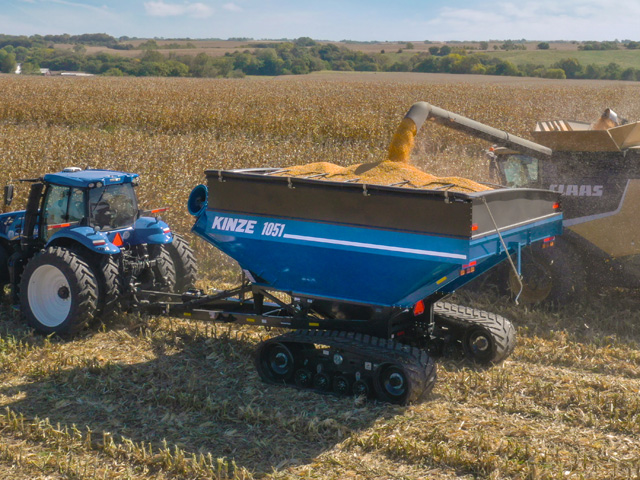Five Grain Cart Maintenance Tips
Grain Cart Maintenance Increases Odds of Efficient Harvest
ANKENY, Iowa (DTN) -- No matter if harvest is underway or about to begin, Justin Render of Kinze Manufacturing recommends farmers perform preventative maintenance on their grain carts -- the "unsung heroes" of fall that keep grain efficiently moving out of the field.
Grain cart maintenance is essential to keep combines rolling, Render said. However, the product specialist also realizes grain carts often aren't at the top of a farmer's to-do list when it comes to making sure equipment is in tip-top condition for harvest.
"The combine is the No. 1 priority and the grain drying and storage systems are probably second. Down the list at three, four or five is probably the grain cart," Render said. "It can be overlooked, even though it's a vital piece of the operation."
It's true that a grain cart has far fewer moving parts to maintain and worry about breaking than a combine, Render continued. But if an auger or bearing gives out on a grain cart, the ability to efficiently shuttle grain from the combine to waiting trucks or wagons is compromised.
"Farmers don't want surprises at harvest," Render said. "That's the biggest reason to keep up with maintenance -- to mitigate downtime."
P[L1] D[0x0] M[300x250] OOP[F] ADUNIT[] T[]
Here are five grain cart maintenance checks recommended by Kinze:
1. Wheels and tracks: Determine if wheel lug nuts are tight and tires have the proper air pressure. For track systems, be sure bogies are in good working order, belt tension is correct and axle bolts are not worn or cracked. When traveling longer distances on pavement, lubricate tracks with graphite or talc to help mitigate excessive wear due to heat buildup.
2. Driveline: Repair or replace any worn driveline components, including gears, shafts and gear boxes. Check that hydraulic hoses and connectors are properly fitted. Inspect the gearbox oil and level to determine if it needs replacing. Most grain carts should be greased weekly or after 40 to 50 hours of service.
3. Augers: For single and dual auger carts, repair or replace any worn parts. Proper auger function is essential to maximize capacity and avoid grain damage during unloading.
4. Cart Body: Inspect the tarp to ensure a tight fit. Look for cracks in side panels or the frame. Check that scales are in good condition and properly calibrated. Inspect harnesses for any wear spots or damage from the previous season.
5. Safety: Check safety chains, draw bar hitch pins and the clevis hitch to make sure they are not bent or broken. Confirm that lighting, turn signals and flashers are working properly, and determine if slow-moving vehicle signs or luminous safety tape needs to be replaced. Make sure that power shaft guards are in place to cover the rotating shaft connecting the tractor to the cart.
Preventative maintenance before harvest starts is important, but Render said daily inspections are just as valuable to avoid breakdowns.
"Most farmers are in a pretty good habit of doing that," he added. "It's good to find something that is just starting to have an issue and take care of it before it's a full-blown issue. Downtime can be costly."
Matthew Wilde can be reached at matt.wilde@dtn.com
Follow him on Twitter @progressivwilde
(c) Copyright 2021 DTN, LLC. All rights reserved.



